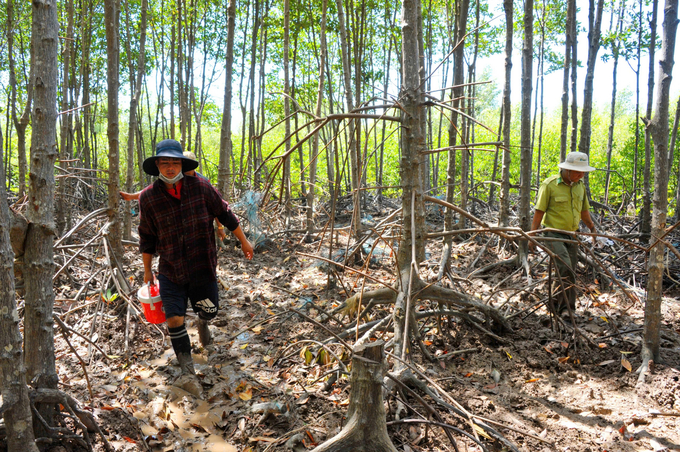
Vietnam is committed to contributing to global blue carbon wealth. Photo: Le Hoang Vu.
Many countries contribute significantly to the global wealth of blue carbon. However, only a fraction of the benefits generated by the process of carbon sequestration remains within the country where the carbon is sequestered. This value is expressed by the amount of carbon sequestered in the country, multiplied by the social cost of carbon (SCC) specific to that nation.
The benefits for other countries are derived by pricing the amount of carbon sequestered in one country using the SCC of other countries. This is known as the "contribution to the outward flow of blue carbon wealth”.
On the other hand, countries also receive blue carbon wealth benefits from carbon sequestration processes occurring in other nations. Therefore, the total contribution of other countries to the global blue carbon ecosystem, aimed at preventing domestic climate damages, is represented by the total amount of blue carbon sequestered in all other countries, valued using the SCC of the home country. This contribution is called the "contribution of blue carbon wealth coming in”.
The difference between the "outward" and "inward" contributions to blue carbon wealth represents the net redistribution of blue carbon assets. Countries with a surplus of blue carbon wealth are referred to as "blue carbon wealth donors", while those with a deficit are known as "blue carbon wealth recipients".
The five largest blue carbon wealth donors, in addition to Australia, are Indonesia, Cuba, Russia, and Guinea-Bissau. These donor countries are characterized by relatively low social cost of carbon (SCC) values - or, in the case of Russia, even negative SCC - and relatively large domestic carbon sequestration potential.
Conversely, the recipient countries with a blue carbon wealth deficit are characterized by relatively high SCC values or a relatively small potential for carbon sequestration within their borders. The five largest blue carbon wealth recipients are India, China, the United States, Pakistan and Japan.
Accordingly, the three countries with the highest social cost of carbon (SCC) values - the United States, India and China - are also the three largest recipients of blue carbon wealth. While the carbon sequestration potential in these countries is not negligible in absolute terms, their high SCC values imply that a significant portion of the global wealth created from the avoided climate damages through carbon sequestration in blue carbon ecosystems belongs to these nations.

Coastal erosion due to climate change: Vietnam is working to mitigate the consequences. Photo: Le Hoang Vu.
Previous analyses, along with the use of a new method to quantify annual national contributions to global blue carbon assets, as well as the net blue carbon wealth donors and recipients worldwide, have provided a clearer picture. Australia, Indonesia and the United States are the three countries with the largest absolute annual blue carbon sequestration potential. These countries are also the top three contributors to global blue carbon wealth, measured by their marginal reduction in global climate change impacts.
The United States derives the greatest benefit from carbon sequestration within the global blue carbon ecosystem. On the other hand, only a small portion of the benefits related to carbon sequestration within the blue carbon ecosystem occurs in Australia, which contributes to the country’s blue carbon assets. When taking into account the differences in climate-related damages experienced by each country, it becomes evident that Australia, Indonesia, and Cuba are the largest contributors to funding blue carbon assets, whereas India, China and the United States are the largest recipients of these assets. By examining estimates of climate damage associated with carbon social costs for individual countries, it becomes possible to better understand how the benefits generated from carbon sequestration in coastal blue carbon ecosystems are distributed around the world.
The carbon sequestration potential estimates referenced in this article are based on global spatial datasets that map blue carbon ecosystems, as well as average global sequestration rates.
Current estimates of blue carbon wealth are typically based on global averages of global social costs, which often overlook the national perspective. While a few national-level analyses, like the one presented here, offer important insights, such as understanding the potential scope for enhancing conservation and restoration efforts.
It is crucial to note, however, that estimates of the redistribution of carbon wealth are generally confined to the sequestration of blue carbon and do not consider cases where a country that receives blue carbon wealth may simultaneously be a major contributor to the wealth of other ecosystems, such as large forested areas. In such cases, the country would also be a significant funder of carbon sequestration efforts in forests, making it a donor of carbon sequestration wealth as well.

![Global Blue Carbon Potential - Lessons for Vietnam: [I] Leading countries in carbon storage](https://t.ex-cdn.com/nongnghiep.vn/resize/174x104/files/linhnhp/2024/11/12/5750-car1-nongnghiep-175745.jpg)
![Global Blue Carbon Potential - Lessons for Vietnam: [II] The potential of coastal carbon sequestration by country](https://t.ex-cdn.com/nongnghiep.vn/resize/174x104/files/linhnhp/2024/11/12/1514-car2-nongnghiep-181504.jpg)
![Global Blue Carbon Potential - Lessons for Vietnam: [I] Leading countries in carbon storage](https://t.ex-cdn.com/nongnghiep.vn/256w/files/linhnhp/2024/11/12/5750-car1-nongnghiep-175745.jpg)
![Global Blue Carbon Potential - Lessons for Vietnam: [II] The potential of coastal carbon sequestration by country](https://t.ex-cdn.com/nongnghiep.vn/256w/files/linhnhp/2024/11/12/1514-car2-nongnghiep-181504.jpg)
